Stock market today: S&P 500 snaps winning streak as Oracle slump weighs on tech
Introduction & Market Context
American International Group (NYSE:AIG) released its first quarter 2025 financial results on May 2, showcasing resilient performance despite significant catastrophe losses from California wildfires. The global insurer reported adjusted earnings per share of $1.17, up 6% year-over-year, while returning approximately $2.5 billion to shareholders through share repurchases and dividends.
AIG’s stock closed at $80.84 on May 1, 2025, down 0.83% ahead of the earnings release. The company’s shares have traded between $69.00 and $88.07 over the past 52 weeks.
Quarterly Performance Highlights
AIG reported mixed financial results for Q1 2025, with strong premium growth on a comparable basis offsetting elevated catastrophe losses. The company achieved Net Premiums Written (NPW) growth of 8% on a comparable basis, though reported NPW remained flat at $4.5 billion.
As shown in the following financial highlights table, AIG’s reported after-tax income per diluted share decreased to $1.16 from $1.74 in Q1 2024, while adjusted after-tax income per diluted share increased 6% to $1.17:
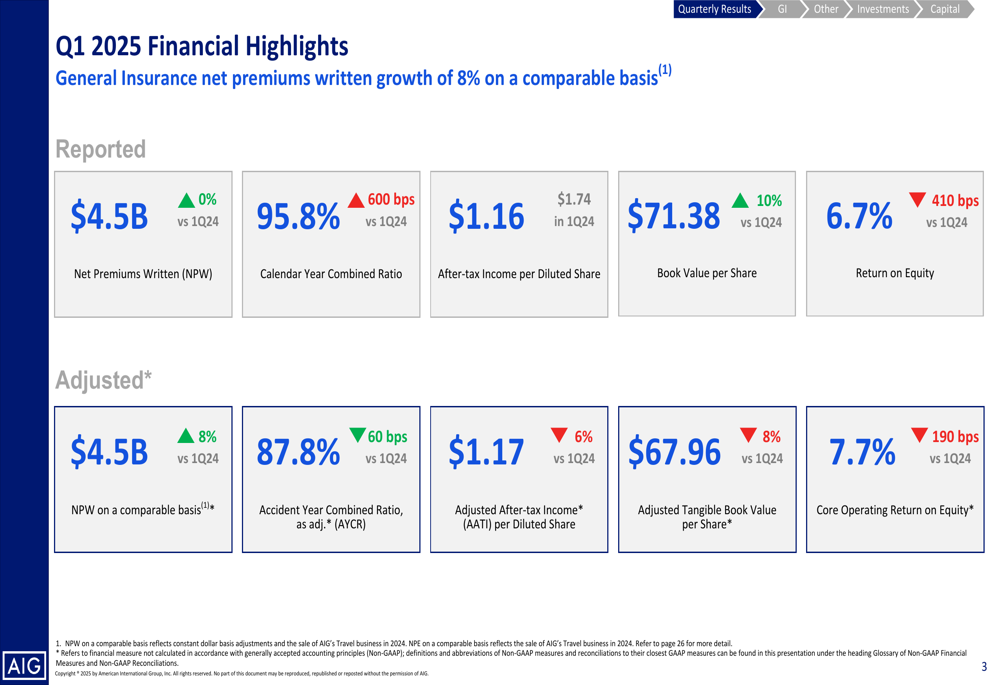
The company’s Calendar Year Combined Ratio deteriorated by 600 basis points to 95.8%, primarily due to catastrophe losses of $520 million compared to $107 million in the prior-year period. However, the Accident Year Combined Ratio, as adjusted, improved by 60 basis points to 87.8%, marking the best first quarter result since the financial crisis and the seventh consecutive year of quarterly improvement.
Peter Zaffino, AIG Chairman & CEO, commented: "While the broader macroeconomic and geopolitical environment remains uncertain, AIG is navigating these challenges from a position of strength given our global diversified portfolio, disciplined underwriting, and resilient balance sheet."
Segment Performance Analysis
AIG maintains a well-diversified business mix across commercial and personal lines, with North America Commercial representing 36% of total premiums, International Commercial 35%, and Global Personal 29%. This diversification has helped the company navigate through challenging market conditions.
The following chart illustrates AIG’s business diversification by segment and product:
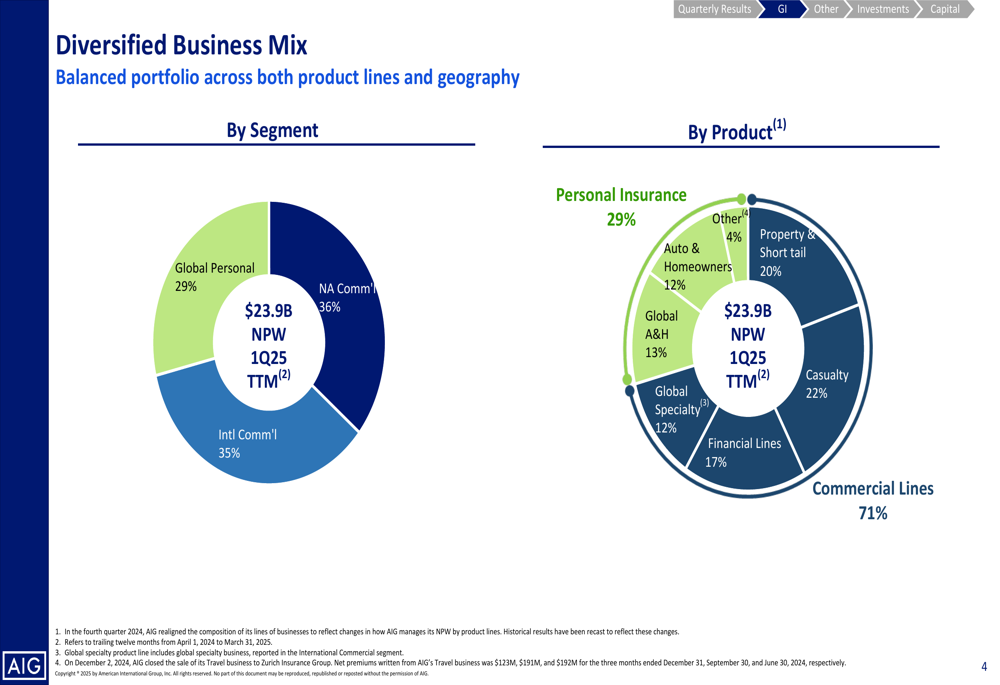
North America Commercial Lines delivered the strongest performance with 14% NPW growth to $1.17 billion, driven primarily by Lexington Insurance. The segment’s Accident Year Combined Ratio improved to 84.3% from 85.9% in the prior-year period, despite significant catastrophe losses of $253 million.
The detailed financial performance of North America Commercial Lines is shown below:
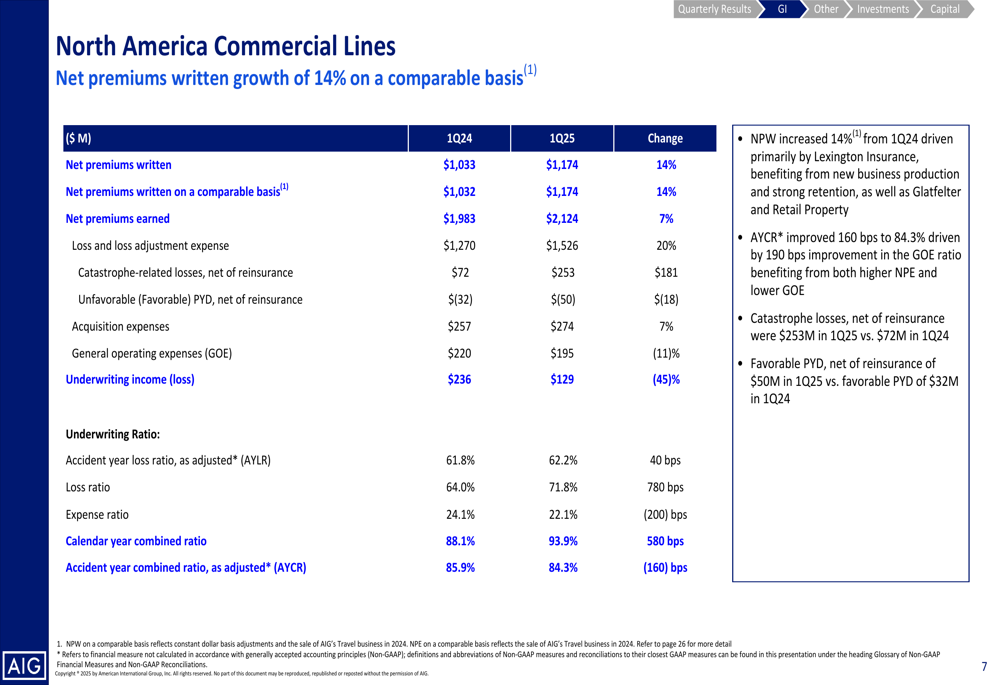
International Commercial Lines also performed well, with NPW growth of 8% on a comparable basis to $2.03 billion. However, the segment’s Accident Year Combined Ratio deteriorated to 85.4% from 83.0%, primarily due to higher catastrophe losses and expenses. This segment has now delivered eight consecutive quarters with a sub-90% Combined Ratio.

Global Personal Insurance faced challenges with a Calendar Year Combined Ratio of 107.9%, resulting in an underwriting loss of $126 million. This deterioration was primarily driven by catastrophe losses of $196 million compared to just $20 million in the prior-year period. However, the Accident Year Combined Ratio improved slightly to 95.6% from 97.0%.
Investment Portfolio and Income
AIG’s investment portfolio totaled $88 billion as of March 31, 2025, with 88% allocated to fixed income asset classes. The company reported that 93% of its bonds are rated NAIC 1 or NAIC 2, indicating high credit quality.
The following chart provides a breakdown of AIG’s investment portfolio:
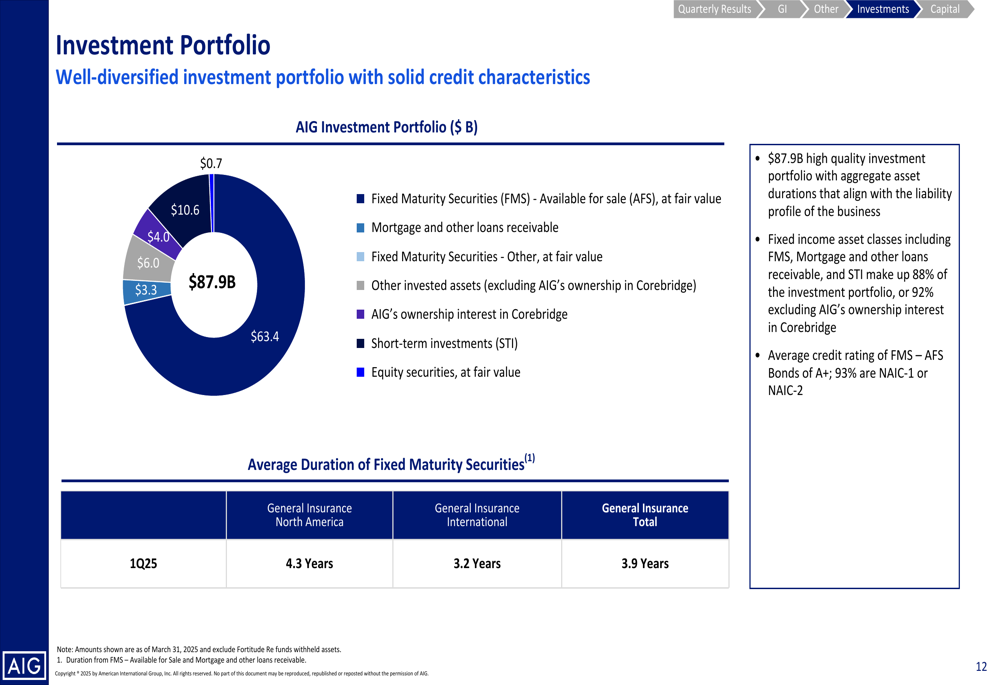
The company’s yield on fixed maturity securities and loans improved to 4.11% in Q1 2025 from 2.55% in Q1 2022, reflecting the higher interest rate environment. This improvement helped drive investment income on these assets to $688 million, up from $517 million in Q1 2022.
As illustrated in the following chart, alternative investment income has declined significantly from its peak in 2022:
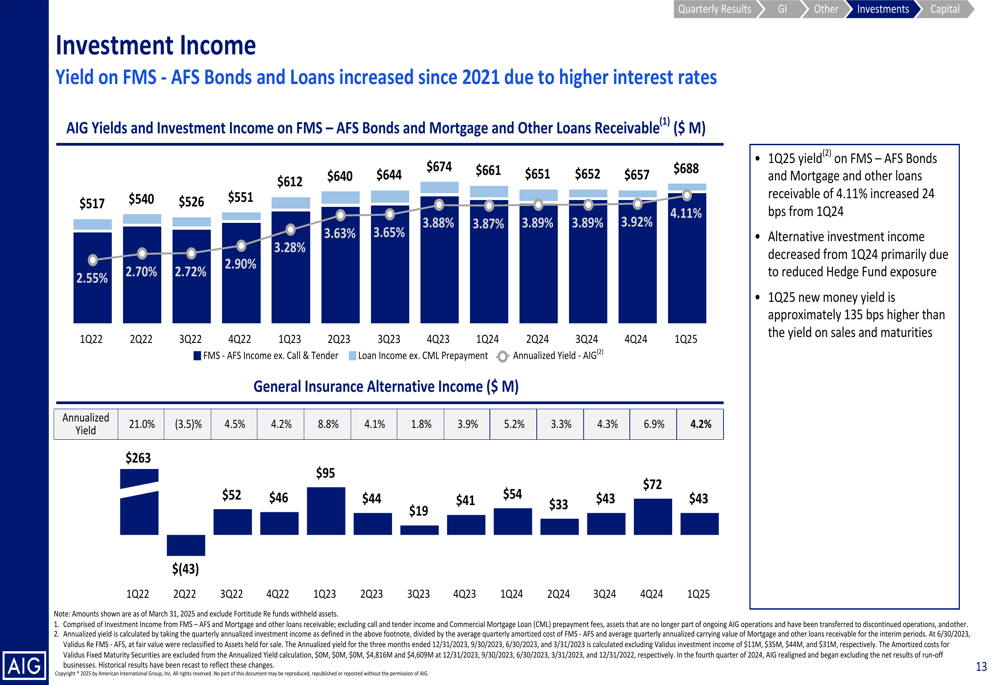
Capital Management and Outlook
AIG continued its aggressive capital return strategy in Q1 2025, repurchasing $2.2 billion of common stock and paying $234 million in dividends. The company’s Board of Directors declared a quarterly dividend of $0.45 per share, representing a 12.5% increase from 2024.
The following chart shows AIG’s consistent share repurchase activity over the past five quarters:
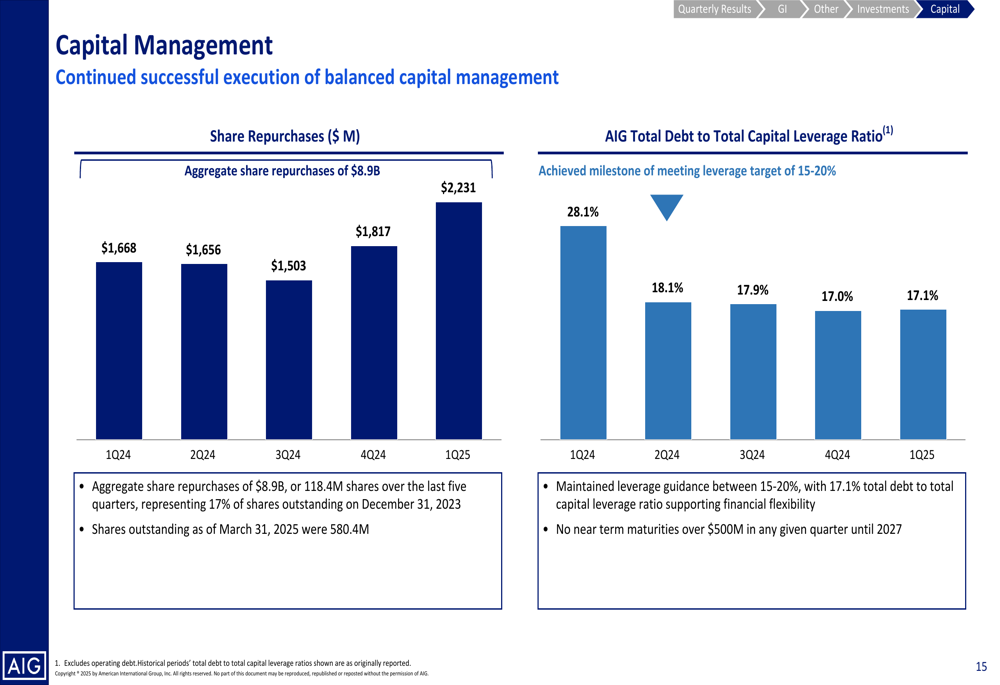
AIG maintained its total debt to total capital ratio at 17.1%, within its target leverage guidance of 15-20%. The company’s U.S. General Insurance Companies reported a Risk-Based Capital (RBC) ratio of 407% at year-end 2024, down from 461% at year-end 2023 but still indicating strong capitalization.
Other Operations reported an adjusted pre-tax loss of $70 million in Q1 2025, an improvement of $135 million from the prior-year period. This improvement was driven by increased net investment income, decreased general operating expenses, and lower interest expense.
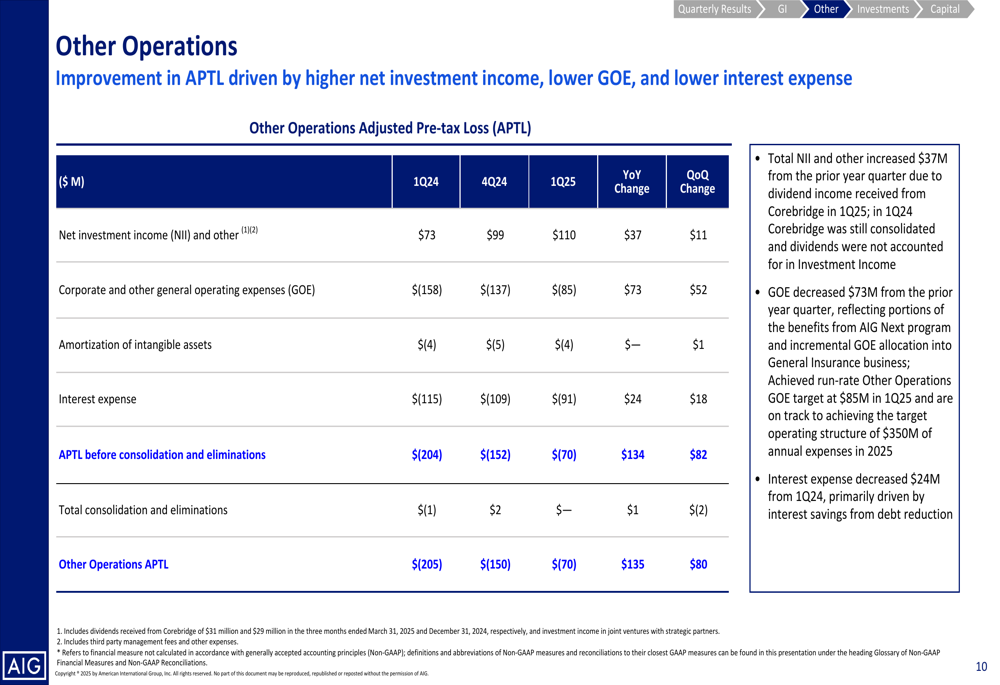
Looking ahead, AIG remains focused on profitable growth and disciplined capital allocation. The company has achieved its run-rate Other Operations general operating expense target while improving the General Insurance general operating expense ratio by 50 basis points year-over-year.
Despite the challenges posed by increased catastrophe activity, AIG’s strong premium growth, improved underlying underwriting performance, and robust capital position suggest the company is well-positioned to navigate the uncertain macroeconomic and geopolitical environment.
Full presentation:
This article was generated with the support of AI and reviewed by an editor. For more information see our T&C.
